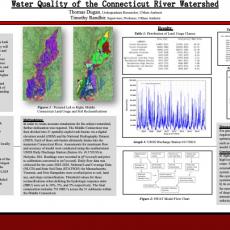
The Middle Connecticut River Watershed is the central sub-basin of the Connecticut River. The Connecticut, being the largest of New England’s rivers, provides 70% of freshwater for the Long Island Sound. The Middle Connecticut Watershed comprises 661,024 acres of land within Vermont, New Hampshire, and Massachusetts. Both Springfield and Northampton are included within this watershed and the system supports seven counties including a strong and productive agricultural community. This project investigates the connection between agricultural land usage and water quality, and its future implications within the watershed using a continuous simulation model. Fluctuations in discharge and pollutant loads influence biodiversity, viability of sensitive ecosystems, bank erosion, and sediment yield. These connections inform and promote proper watershed management and can result in higher water quality for communities supported by the system.
This internship involved developing a skill-set in watershed modeling as well as Geographic Information Systems. Prior to the internship, I was unfamiliar with these programs and so this was a welcome challenge. The Environmental Protection Agency (EPA) Basins 4.5, as well as the ArcMap Geographic Information System were used to collect datasets relating to soil classifications, land usage, and elevation throughout the region. The watershed was delineated and 31 spatially explicit sub-basins were formed. Previous papers on the Connecticut River watershed were referenced prior to creation of slope and land classes as well as the definition of hydrologic response units. Ultimately, the region had over 700 hydrologic response units. Climate data and input tables were developed prior to the finalization of the model. Multiple simulations were conducted in comparison with historical data provided through United State Geologic Survey (USGS) Discharge and Quality Stations to assess the state of the watershed. Finally, comparisons between land usage and quality outputs provided by the simulation were analyzed to develop possible mitigation techniques to reduce pollutant and nutrient loads.
This internship helped me to realize that I have a passion for research beyond an undergraduate level. I had been contemplating graduate school during my studies, but I was unsure whether it would be the right decision given timing, work opportunities, and also personal questioning as to whether I was confident enough to complete a Master’s Degree program. Through this internship I was able to develop autonomy and curiosity, honing both my critical thinking and inquiry skills. Pollution, specifically in water systems, has long been an interest and a drive of mine. This project provided an opportunity to take prior knowledge I had built during my education and apply it directly to a passion. I also found through this internship that I have an interest in modeling software and the systems approach when addressing a problem. I currently have the goal of becoming an environmental toxicologist, for which I often pictured myself involved in laboratory work, testing samples and so on. This internship has made me rethink how I approach environmental issues, both in problem assessment and remediated application.
